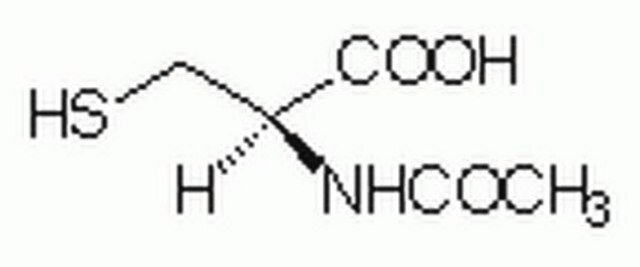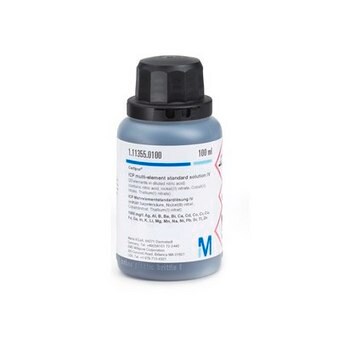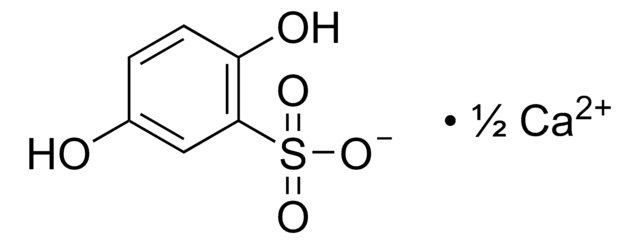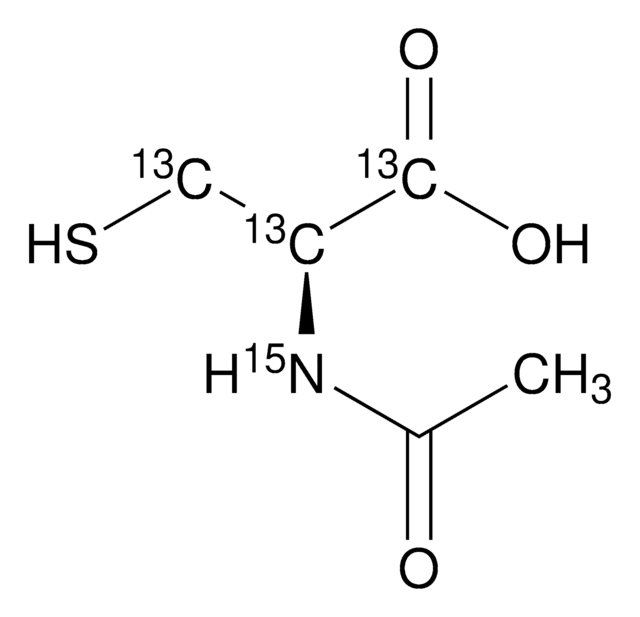Kluczowe dokumenty
1009005
USP
Acetylcysteine
United States Pharmacopeia (USP) Reference Standard
Synonim(y):
N-Acetyl-L-cysteine, LNAC, NAC
About This Item
Polecane produkty
klasa czystości
pharmaceutical primary standard
rodzina API
acetylcysteine
producent / nazwa handlowa
USP
mp
106-108 °C (lit.)
Zastosowanie
pharmaceutical (small molecule)
format
neat
temp. przechowywania
2-8°C
ciąg SMILES
CC(=O)N[C@@H](CS)C(O)=O
InChI
1S/C5H9NO3S/c1-3(7)6-4(2-10)5(8)9/h4,10H,2H2,1H3,(H,6,7)(H,8,9)/t4-/m0/s1
Klucz InChI
PWKSKIMOESPYIA-BYPYZUCNSA-N
Szukasz podobnych produktów? Odwiedź Przewodnik dotyczący porównywania produktów
Opis ogólny
Zastosowanie
Also used to prepare standard stock and standard solution for assay by using the liquid chromatography method in conjunction with uv detector according to the given below monographs of United States Pharmacopeia (USP):
- Acetylcysteine Solution
- Acetylcysteine
- Acetylcysteine Compounded Solution
Działania biochem./fizjol.
Komentarz do analizy
Inne uwagi
produkt powiązany
Hasło ostrzegawcze
Warning
Zwroty wskazujące rodzaj zagrożenia
Zwroty wskazujące środki ostrożności
Klasyfikacja zagrożeń
Eye Irrit. 2
Kod klasy składowania
13 - Non Combustible Solids
Klasa zagrożenia wodnego (WGK)
WGK 2
Temperatura zapłonu (°F)
Not applicable
Temperatura zapłonu (°C)
Not applicable
Certyfikaty analizy (CoA)
Poszukaj Certyfikaty analizy (CoA), wpisując numer partii/serii produktów. Numery serii i partii można znaleźć na etykiecie produktu po słowach „seria” lub „partia”.
Masz już ten produkt?
Dokumenty związane z niedawno zakupionymi produktami zostały zamieszczone w Bibliotece dokumentów.
Klienci oglądali również te produkty
Nasz zespół naukowców ma doświadczenie we wszystkich obszarach badań, w tym w naukach przyrodniczych, materiałoznawstwie, syntezie chemicznej, chromatografii, analityce i wielu innych dziedzinach.
Skontaktuj się z zespołem ds. pomocy technicznej









